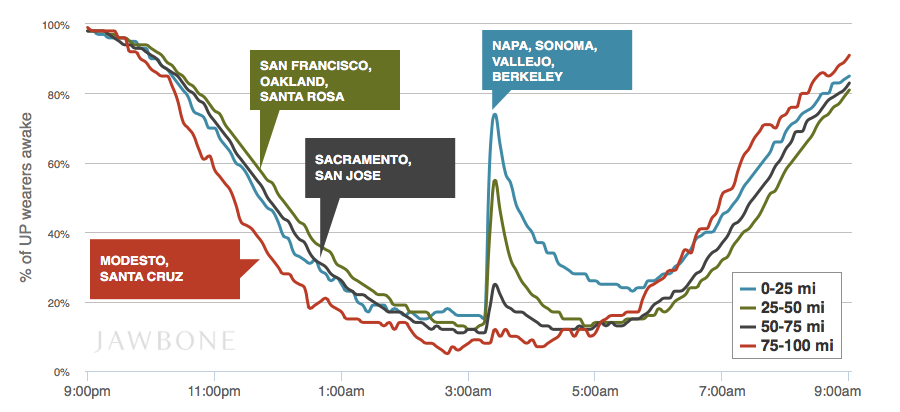USC's mHealth Collaboratory Explores New Frontier of "Quantified Self" Personal Data Monitoring Tech
As the self-tracking movement goes mainstream, researchers see unprecedented opportunities.
In the days following the late-August earthquake in Napa, California, a high-tech manufacturer called Jawbone analyzed sleep data from thousands of users of its UP wristband, a device that monitors its wearer's physical activity. The company used the data to produce a map showing exactly what time people were jolted awake on the night of the quake, based on their distance from the epicenter –information of great potential importance to public safety and emergency response agencies.
The wake-up map was just one recent example of the promise of massive amounts of personal data for the expanding field of mobile health (mHealth). Dubbed the quantified self (QS) movement, the rapid rise of self-monitoring technologies gives us new insights into people’s daily lives, via wearable and mobile devices that constantly collect data about a person's exercise, movement, heart rate, and other observations.
But self-monitoring also has implications of incalculable value for health researchers and clinicians, said Donna Spruijt-Metz, PhD, director of the mHealth Collaboratory, a program of the USC Dornsife Center for Economic and Social Research that was recently established to drive advances in mHealth.
That's why the mHealth Collaboratory hosted the Quantified Self Los Angeles (QSLA) Show & Tell Meetup on August 26. It is one of 112 QS Meetup groups around the world, loosely organized by California-based Quantified Self.
"The tools that self-monitoring enthusiasts and companies are developing will be a key part of mHealth progress at USC and other research institutions," said Spruijt-Metz, who is also adjunct associate professor of Preventive Medicine at Keck School of Medicine and of Psychology. "The mHealth Collaboratory is here to get scientists, business people, and the innovative user community talking together and inspiring each other to develop disruptive new mobile health solutions."
Existing self-monitoring products, such as sensor-packed wristbands from companies like Jawbone and Fitbit, typically work in sync with computer or smartphone apps. They track and analyze objective data such as exercise and activity, geographical movement, calories, and sleep patterns.
But that's just the beginning, said QSLA Meetup organizer Ernesto Ramirez, a PhD candidate in a joint program on public health at the University of California San Diego and San Diego State University.
"The quantified self technologies present endless possibilities from a public health standpoint for collecting data and insights for public health research and interventions," said Ramirez. "To collect data on this scale through traditional methods would be prohibitively expensive, or impossible."
The technology will empower clinicians, who will be able to more accurately track and assist the health conditions of individual patients with a range of conditions, including chronic issues such as diabetes and heart disease, said Spruijt-Metz. At the same time, researchers will be able to easily gather high-quality data from hundreds or thousands of participants that could speed the development of new drugs or other health interventions.
Approximately 25 self-trackers attended the Meetup, including a few researchers and self-tracking application developers.
Such early adopters are themselves important to USC researcher Gillian O'Reilly, a PhD candidate in the Division of Health Behavior research in the Department of Preventive Medicine, Keck School of Medicine of USC. O'Reilly is currently conducting research to identify personality characteristics associated with enthusiastic and diligent self-monitoring.
"Not everyone likes the idea of self-tracking, and some people are suspicious of sharing that data with researchers," O'Reilly said. "My goal is to understand the barriers and develop interventions that could motivate people to stick with it."




